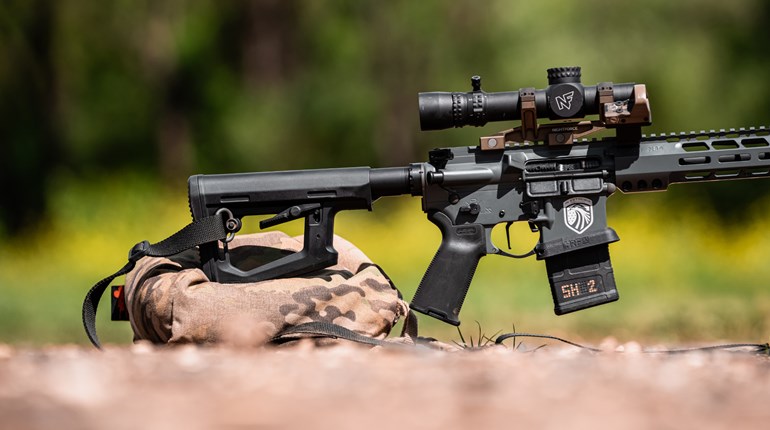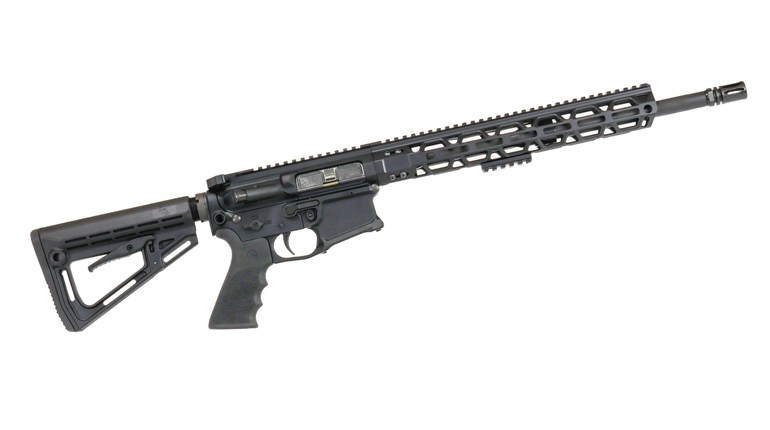
First, Kel-Tec introduced the RDB, a conventional (if that term may be applied to a bullpup) rifle with a pistol grip. Then came RDB-C, a sci-fi-looking, gripless variant which proved remarkably ergonomic for precision shooting. The RDB-C is also legal in several states where the regular RDB isn't. As an encore, the company released the Kel-Tec RDB-S Survival carbine in 2018, which one-ups the unconventional design of the RDB-C with an adjustable length of pull and distinctive flip-up sights. Finally shipping after a low-key introduction in 2017, the Kel-Tec RDB-S, chambered in 5.56 NATO, is even lighter than the already-slim RDB-C and stows away into smaller spaces.

All Kel-Tec RDB variants operate with a long-stroke regulated gas piston. The RDB bolt travels past the magazine a considerable distance to reach the ejector, lengthening the cycle duration and minimizing felt recoil. By the time the bolt face reaches the back of the magazine, it's already moving fast for extra feeding reliability. The adjustable gas regulator allows even greater reduction of recoil through proper tuning.
The bolt and carrier are fairly lightweight compared to most long-stroke piston designs. The long duration of each feeding cycle combined with the reduced weight of the traveling bolt minimizes felt recoil, despite the bantam weight of the rifle. Unlike the popular AR-15, the Kel-Tec RDB-S Survival carbine's firing pin is sprung against accidental primer ignition. George Kellgren and Tobias Obermeit, the gun's designers, managed to create an excellent three-pound trigger that also delivers a positive firing-pin impact on the primer.

Fired casings fall out behind the magazine, making it usable for right- and left-handed shooters alike. Another great advantage of this arrangement is empty casings don’t end up in the faces of people next to the shooter or bounce off a barricade or wall into the shooter’s face or arms. The downside is slower administrative chamber checks than on a conventional rifle, as the magazine has to be removed first. The RDB-S is compatible with all standard AR-15 magazines on the market. In another win for ambidexterity, the non-reciprocating charging handle may be swapped from side to side. In the rearmost position, the charging handle can be locked up into an optic-rail recess similar to the Heckler & Koch MP5. Speaking of the MP5, the Kel-Tec RDB-S Survival, with its non-NFA 16.1-inch barrel, is the same size and weight as the NFA-regulated MP5 PDW with a 6-inch barrel!

At first glance, the thin, visually short barrel is the most prominent feature of the Kel-Tec RDB-S Survival carbine. Most of it is covered by the fore-end, so only a small portion protrudes. A tall, stamped-steel, folding front sight and its base make the barrel look even shorter. Both the front and the peep-on-post rear sight co-witness with red dots or fold flat to make room for a scope. Since the stamped front-sight protector is edge-on and almost invisible to the shooter, it can be used like a red dot with both eyes open, especially with a fiber-optic front post. The sight radius is similar to the M4-style carbine, so fans of the AR-15 won't notice much difference in off-hand accuracy when shooting the RDB-S.

While the barrel is threaded for an extension under the front sight base, the thread protector is nearly flush with the base, and the entire construction looks unconventional. Fortunately, the thread protector comes off and may be replaced by a 5/8x28 TPI thread extender for flash hiders or muzzle brakes. Since the rifle, like other RDB models, produces minimal muzzle rise, an A2 flash hider or a Kaw Valley linear compensator worked best, the latter channeling much of the noise away from the shooter.
The RDB-S also works well with sound suppressors; the extra weight at the end of the barrel actually improves accuracy without causing gas blowback to the shooter. The barrel weighs a fraction over one pound, allowing the whole rifle to weigh only five pounds, less than the M1 Carbine or most submachine guns. While 16 inches is enough to produce high muzzle velocity, it's insufficient for complete powder burn; the Kel-Tec RDB-S Survival carbine makes a rather bright fireball.

The overall length of the Kel-Tec RDB-S Survival carbine is around 24.5 inches with the stock collapsed. Pulling on the stock clicks it open, and pressing a latch on the underside of the buttpad releases it. Extended, it brings the overall length past the legally mandated 26 inches. Length-of-pull difference is about 2.5 inches, making for a comfortable, bladed position when fully extended and equally comfortable isosceles in closed.
The unconventional hold without a pistol grip places the hand in line with the bore, making point-shooting more intuitive and preventing top-mounted optics from rolling the gun in a shooter's hand during target transitions. For shooters with small hands, I would recommend stick-on pads to thicken the grip, bringing the hand closer to the trigger. Field-stripping takes very little time, as three captured pins hold everything together.

One interesting thing to note is all three RDB models can interchange furniture easily. For example, I added an S-model folding front sight to the 24-inch barrel of the C model, creating a classic marksman design with 20 inches of sight radius. A word of caution: combining an RDB-S barreled action with an RDB-C or RFB buttstock should be avoided, because this creates an NFA-regulated short-barreled rifle, since the overall length falls below the mandated 26-inch minimum.
Shooting the ultra-light Kel-Tec RDB-S Survival carbine produced some good groups. I got 1.5 MOA with 55-grain Winchester Silvertips and with Winchester "white box" ball ammunition of the same bullet weight. Hornady 55-grain Varmint rounds grouped 1.275 MOA, and Hornady American Gunner 55-grain FMJ groups measured 1.75 MOA. Somewhat predictably, given the fast 1:7-inch rate of twist, 75-grain Hornady Black and 69-grain Federal Premium Gold Medal Match both came in at 1.2 MOA. For hunting, a magnified optic would help take advantage of the mechanical accuracy. With the back-up sights fixed to the gun, such an optic might best serve atop a quick-detach scope mount.

In the field, off-hand accuracy was also excellent, due to the neutral balance of the rifle and the shooter's support hand being near the muzzle. The thin barrel does not stand up well to endurance shooting, with 10 rounds being sufficient to warm it up, and 60 rounds fired back-to-back is the realistic rapid-fire limit for the carbine, due to the top of the receiver warming up. However, seeing as the Kel-Tec RDB-S is designed for survival use, it doesn't seem likely that there would be any hunting/defensive situation to which this rifle would be applied that would take more than 60 rounds to solve. While the heavier barrel of the C model is more suitable for both bench-rested accuracy and sustained fire, the RDB-S is very capable of placing expanding hunting bullets where they need to go to either secure meat or to stop threats. In recognition of the stow-away survival role, the RDB-S ships with a flush-fitting, 10-round Magpul magazine.

A Kel-Tec RDB-S Survival carbine with a red-dot optic and a full magazine weighs the same as an unloaded, M4-style AR-15 without an optic. The 5-pound weight and centered balance point makes one-handed control possible, which adds to the emergency-readiness aspect of the gun. The RDB-S is also excellent for teens or small-statured shooters, since it's easy to handle and doesn't inflict punishing recoil. Overall, the RDB-S is a reliable, comfortable carbine that fits easily into a survival pack. Its looks may be unconventional, but it delivers both ergonomics and accuracy traditionally prized by hunters, shooters and survivalists. MSRP is $1,456.



































